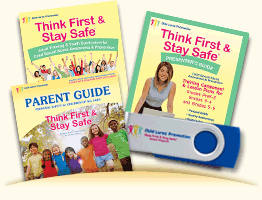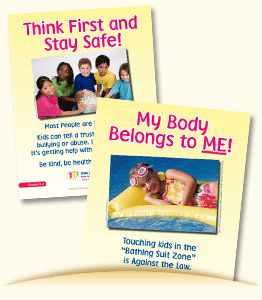FAQ: Grades 3-4 & 5-6 Curriculum
What do students learn when they participate in the Think First & Stay Safe™ School Program?
The earlier we begin to teach children the basics of healthy social relationships and respecting self and others, the better able are we to stop the cycle of abuse, both by peers and adults. In doing so, we help keep children safe, healthy and ready to learn.
The most prevalent personal safety issues facing children today involve bullying and sexual exploitation, including web-enabled offenses. Fortunately, most of these crimes are preventable with awareness and education.
Think First & Stay Safe program provides developmentally appropriate instruction on:
- healthy and respectful relationships (family and social)
- setting, maintaining and respecting personal boundaries.
- developing and maintaining effective communication with trusted adults.
- recognizing bullying and sexually offending behaviors & learning prevention strategies.
- gaining awareness of available local and national resources (including for youngsters having thoughts of abusing others)
- reporting any type of abuse or threat to a youngster's health and safety.
- reducing the feelings of guilt and blame often experienced by children who are mistreated.
Do I have to buy separate age-appropriate programs/curricula for different grade levels?
No. All six age-appropriate curricula modules (PreK-K, Gr1-2, Grades 3, 4, 5 and 6 are included with the purchase of comprehensive the Think First & Stay Safe™ program. (See details in next FAQ question below). You choose the module(s) your school or institution will teach based on your student body.
Is the Think First & Stay Safe™ curriculum evidence-based?
Yes. Think First & Stay Safe™ is based on data from original research by Ken Wooden, educator/author/investigative journalist, and ongoing research by his colleagues of thirty three years, Jennifer Mitchell and Rosemary Webb. Jennifer and Rosemary co-wrote the program and have been instrumental in expanding it to address all forms of abusive behavior, including bullying and harassment. Jennifer & Rosemary oversee each annual program update to ensure best practices and the most relevant and balanced approach to teaching personal safety to today's technologically savvy youngsters. (SEE ALSO "History of the Child Lures School Program")
Independently-conducted comprehensive program evaluations document efficacy of the Think First & Stay Safe curriculum. These scientific evaluations were conducted by professionally-qualified evaluators, contracted by school districts. A current eight-year program evaluation (2010-2018) of Think First & Stay Safe was presented at the National Children's Alliance Leadership Conference in Washington, D.C. on June 11, 2018. The evaluation includes nearly 40,000 students from 1800 classrooms where prevention educators made five consecutive visits into each individual classroom for approximately 30-45 minutes each day. The evaluation documents students' consistent annual increase in personal safety knowledge and skills. (All data has been analyzed by a professional statistician and is considered statistically significant.)
How often is Think First & Stay Safe™ updated?
Since its original creation, Rosemary Webb and Jennifer Mitchell have continuously updated and expanded Think First & Stay Safe™ to address the latest issues and safety concerns facing today's youngsters. These updates are based on Child Lures Prevention's ongoing research, as well as the invaluable input of educators, parents and students. The program was most recently updated and revised in January 2021.
Does the program offer a balanced perspective?
Yes. Youngsters are repeatedly reassured that the majority of people, including peers, are sincerely committed to the happiness and well-being of children and do not mistreat them. Those who harm or abuse children are the exception.
Has the program been scientifically evaluated?
Yes. Think First & Stay Safe™ School Program has been scientifically evaluated and shown to be highly effective in safeguarding youngsters, based on the federally-mandated Principles of Effectiveness. (See "Program Evaluations")
Formative assessments are incorporated throughout each Lesson Plan. A formal Summative Program Assessment is provided for student evaluation of mastery. To document student progress and program retention in-house, schools and organizations are encouraged to administer the provided Program Evaluations for Grades 3-4 and Grades 5-6 as both a Pre-Test and a Post-Test.
Think First & Stay Safe School Program aligns with recommendations set forth by NCMEC's guidelines for personal safety programs, as well as National Health Education Standards.
Does Think First & Stay Safe™ address bullying?
Yes, students are taught the importance of treating others with kindness and respect at home, at school and online/electronically. Grades 3-4 have a dedicated Lesson Plan addressing bullying, cyberbullying and electronic harassment entitled, Be Kind, No Bullying. Grades 5-6 participate in the comprehensive lesson, Bullying, Cyberbullying and Harassment. Students learn the value of using Netiquette at all times, as well as how to stand up for others and get help from trusted adults.
Does the program address peer-to-peer bullying and abuse?
Yes. The program addresses peer-to-peer abuse. It allows students to practice effective strategies to prevent, deflect and report bullying, based on the most recent research. School/state policies and consequences are reviewed.
As much as 30% of all childhood sexual abuse is perpetrated by children, on children. The Think First & Stay Safe program emphasizes that it is against the law for anyone - even a peer - to cross over the line from affection to sexual abuse.
Is Think First & Stay Safe™ age-appropriate?
Yes. The Presenter's Guide contains age-appropriate lesson plans for PreK-K, Grades 1-2, Grade 3, Grade 4, Grade 5 and Grade 6. Presenters are encouraged to fine-tune each lesson, based on the maturity and sophistication of students.
Classroom Activities, Practice Scenarios and Posters differ for Grades 3 and 4, as well as for Grades 5 and 6.
What does the program kit consist of?
-
- Teacher Manuals: Presenter's Guide: Includes age-appropriate scripted lesson plans, classroom activities, practice scenarios, follow-up activities, pre/post tests, and tools for parental involvement. Six manuals: PreK-K, Grades 1-2, Grade 3, Grade 4, Grade 5 and Grade 6.
- Presenter's Training Modules I-V: Training Modules introduce and guide trainees through the program. (Approx. 15-20 min/ea)
- Welcome Module - (4 min.)
- Module I, Part 1 - Curriculum Introduction
- Module I, Part 2 - Child Sexual Abuse: Definitions, Facts & Myths and Reporting
- Module II - Presentation Preparation
- Module III - PreK-K and Grades 1-2 Implementation
- Module IV - Grades 3 & 4 Implementation
- Module V - Grades 5 & 6 Implementation
-
- Student Videos:
- Luring: What Would You Do?: Four realistic dramatizations allow students to clearly visualize just how easily they may be lured into victimization. (Recommended for Grades 3 and up.)
- Tom's Secret: All Secrets Can Be Told; for Grades 3-6.
- Student Videos:
-
- Classroom PowerPoint Presentations for PreK-K, Grades 1-2 and Grades 3, 4, 5 and 6
- Student Workbook for Grades 3-6: Allows students to follow along with each Lesson Plan and complete activities; may serve as a home reference guide once completed.
⇓ View 5 Page Sample from Student Workbook - Parent Guide: This 20-page parent handbook summarizes the School Program and offers ideal home reinforcement. Available in English and Spanish.
⇓ View Parent Guide Sample

View Grades 3-4 Classroom Poster Series:
⇓ English | ⇓ Spanish
- Think First and Stay Safe!
- All Secrets Can Be Told.
- My Body Belongs to ME!
- Be Kind Online.
- Stay Three Steps Back.
- Trust Your Gut Feelings.
- There's No Lost Puppy!
View Grades 5-6 Classroom Poster Series:
⇓ English | ⇓ Spanish
- Too Smart to be Lured.
- Trust Your Gut.
- All Secrets Can Be Told.
- Be a Good Digital Citizen.
- Exclusion Hurts.
- No Threats. (No Kidding!)
- Intolerance is Intolerable.
- Sober = Safer
- No Weapons; No Exceptions.
Who teaches Think First & Stay Safe™?
Typically, the program is taught by a school counselor, health educator, nurse, physical education teacher or school resource officer. In some schools, classroom teachers present the Program. It is suggested that guidance counselors act as coordinators and be readily available for victimized children's needs.
Educators who teach personal safety help ensure students come to school prepared to learn - free of the challenges associated with abusive treatment, including behavioral problems, learning disabilities, low self-esteem, depression and peer/self-exploitation.
How long does it take to teach the program?
Think First & Stay Safe™ can conform to the time constraints of any classroom. Its scripted lesson plans are designed to be taught in approximately 10-15 minutes. Many presenters opt to follow the suggested presentation timetables found in the Presenter's Guide manuals; others create their own.
How do we involve parents?
For prevention programs to be most effective, the support and cooperation of parents and guardians is needed.
Prior to classroom presentations, schools are encouraged to send home a Welcome Letter (templates for each grade are included in the Presenter's Guide manuals.) The letter to parents and guardians include a link and password to (3) Parent and Guardian Training Modules, available for free online viewing.
Distribution of the Think First & Stay Safe™ Parent Guide gives parents and other caregivers the ability to reinforce prevention strategies at home. Parents should also receive a copy of the take-home flyer, "Tips for Parents," located in the Presenter's Guide. Schools are also welcome to link to childlureprevention.com for free additional resources and information for parents and schools alike.
Distribution of the Parent Guide is strongly encouraged. Home reinforcement helps ensure students retain this invaluable information. It is also a visible way for schools to demonstrate compliance with federal educational entitlements calling for parental involvement.
Does the Think First & Stay Safe™ curriculum have permanence?
Yes. Once a school district or one of its schools adopts the Think First & Stay Safe™ curriculum, it becomes a permanent resource that may be incorporated into the existing health curriculum. Targeted grades, as well as new students and personnel, can be trained each year.
How do we fund this program for each school in our district?
Schools employ Title I funding, Safe Schools/Healthy Kids Initiative, At-Risk Funds, PTA/PTO sponsorship, as well as general funds. Area businesses and civic organizations are usually more than willing to sponsor the Think First & Stay Safe™ School Program and/or Student Workbooks and Parent Guides for local schools. Click here for more information on funding options.
Can I read references or testimonials from schools that have implemented Think First & Stay Safe™?
Yes. Please see our Success Stories
How do I preview Think First & Stay Safe™ for my school or school district?
We welcome your request to preview the Think First & Stay Safe™ Adult Training and Youth Curriculum materials. The process is simple:
-
-
- At your request, we send curriculum information.
- We are happy to provide additional information or materials, should you need them.
- We are readily available to answer any questions that may arise during your preview period.
-
To arrange a preview of the Think First & Stay Safe™ Adult Training and Youth Curriculum materials, please e-mail us the name, address and phone number of your organization, as well as a contact name.
